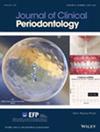Proteome‐Guided Drug Target Discovery for Periodontitis
IF 6.8
1区 医学
Q1 DENTISTRY, ORAL SURGERY & MEDICINE
引用次数: 0
Abstract
Background and ObjectivePeriodontitis is a chronic inflammatory disease driven by immune dysfunction and microbial imbalance. This study aims to identify circulating druggable proteins causally linked to the disease.Materials and MethodsWe integrated proteomics data from deCODE genetics with periodontitis genome‐wide association studies (GWAS) from the Million Veteran Program to identify proteins associated with periodontitis. Findings were replicated using GWAS data from the Gene‐Lifestyle Interactions in Dental Endpoints consortium. Causal associations were validated using genetic and statistical methods, and the identified proteins were assessed for biological relevance and druggability.ResultsAmong the 2088 evaluated proteins, three showed robust evidence of causal association with periodontitis: FGF2 (fibroblast growth factor 2) (odds ratio [OR]: 1.06, 95% confidence interval [CI] 1.032–1.082), AZGP1 (zinc‐alpha‐2‐glycoprotein) (OR: 1.12, 95% CI 1.058–1.189) and BTC (betacellulin) (OR: 0.86, 95% CI 0.789–0.942). Replication analysis confirmed associations for 18 proteins, with 16 showing high colocalisation. Further evaluation of drug target databases revealed indirect links between the identified proteins and approved therapies for inflammatory conditions, suggesting potential therapeutic relevance.ConclusionThis study identifies three circulating proteins—FGF2, AZGP1 and BTC—as causally associated with periodontitis, highlighting their potential as therapeutic targets. These results provide a foundation for future research into targeted therapies for periodontitis.蛋白质组引导的牙周炎药物靶点发现
背景与目的牙周炎是一种由免疫功能障碍和微生物失衡引起的慢性炎症性疾病。这项研究旨在确定与该疾病有因果关系的循环药物蛋白。材料和方法我们将来自deCODE genetics的蛋白质组学数据与来自百万退伍军人计划的牙周炎全基因组关联研究(GWAS)相结合,以鉴定与牙周炎相关的蛋白质。研究结果使用来自牙科终点基因-生活方式相互作用联盟的GWAS数据进行了重复。使用遗传和统计方法验证因果关系,并评估鉴定的蛋白质的生物学相关性和药物性。结果在评估的2088种蛋白中,有3种蛋白显示出与牙周炎相关的有力证据:FGF2(成纤维细胞生长因子2)(比值比[OR]: 1.06, 95%可信区间[CI] 1.032-1.082)、AZGP1(锌- α - 2 -糖蛋白)(比值比:1.12,95% CI 1.058-1.189)和BTC (β细胞蛋白)(比值比:0.86,95% CI 0.789-0.942)。复制分析证实了18种蛋白质的相关性,其中16种显示高共定位。对药物靶标数据库的进一步评估显示,鉴定的蛋白质与已批准的炎症治疗之间存在间接联系,这表明潜在的治疗相关性。本研究确定了三种循环蛋白fgf2、AZGP1和btc与牙周炎有因果关系,突出了它们作为治疗靶点的潜力。这些结果为进一步研究牙周炎的靶向治疗奠定了基础。
本文章由计算机程序翻译,如有差异,请以英文原文为准。
求助全文
约1分钟内获得全文
求助全文
来源期刊

Journal of Clinical Periodontology
医学-牙科与口腔外科
CiteScore
13.30
自引率
10.40%
发文量
175
审稿时长
3-8 weeks
期刊介绍:
Journal of Clinical Periodontology was founded by the British, Dutch, French, German, Scandinavian, and Swiss Societies of Periodontology.
The aim of the Journal of Clinical Periodontology is to provide the platform for exchange of scientific and clinical progress in the field of Periodontology and allied disciplines, and to do so at the highest possible level. The Journal also aims to facilitate the application of new scientific knowledge to the daily practice of the concerned disciplines and addresses both practicing clinicians and academics. The Journal is the official publication of the European Federation of Periodontology but wishes to retain its international scope.
The Journal publishes original contributions of high scientific merit in the fields of periodontology and implant dentistry. Its scope encompasses the physiology and pathology of the periodontium, the tissue integration of dental implants, the biology and the modulation of periodontal and alveolar bone healing and regeneration, diagnosis, epidemiology, prevention and therapy of periodontal disease, the clinical aspects of tooth replacement with dental implants, and the comprehensive rehabilitation of the periodontal patient. Review articles by experts on new developments in basic and applied periodontal science and associated dental disciplines, advances in periodontal or implant techniques and procedures, and case reports which illustrate important new information are also welcome.
 求助内容:
求助内容: 应助结果提醒方式:
应助结果提醒方式:


